Hello, and welcome to Fundamental Friday, where I teach the basics of cooking and baking. And while cheese plate ideas might not rank high on your list of fundamentals, there are some basic rules to follow to make the best cheese board you can.
Another great Fundamental Friday post is how to pair flavors.
Stay tuned for all the info you need on choosing cheese for your cheese platter, how to slice cheese for a cheese course, and what to serve on your cheese plate besides cheese (homemade crackers and fig jam come to mind.)
Whether you serve your cheese platter after dinner, in lieu of dessert, or as an communal appetizer at a party, always think “balance,” and you can’t go wrong.
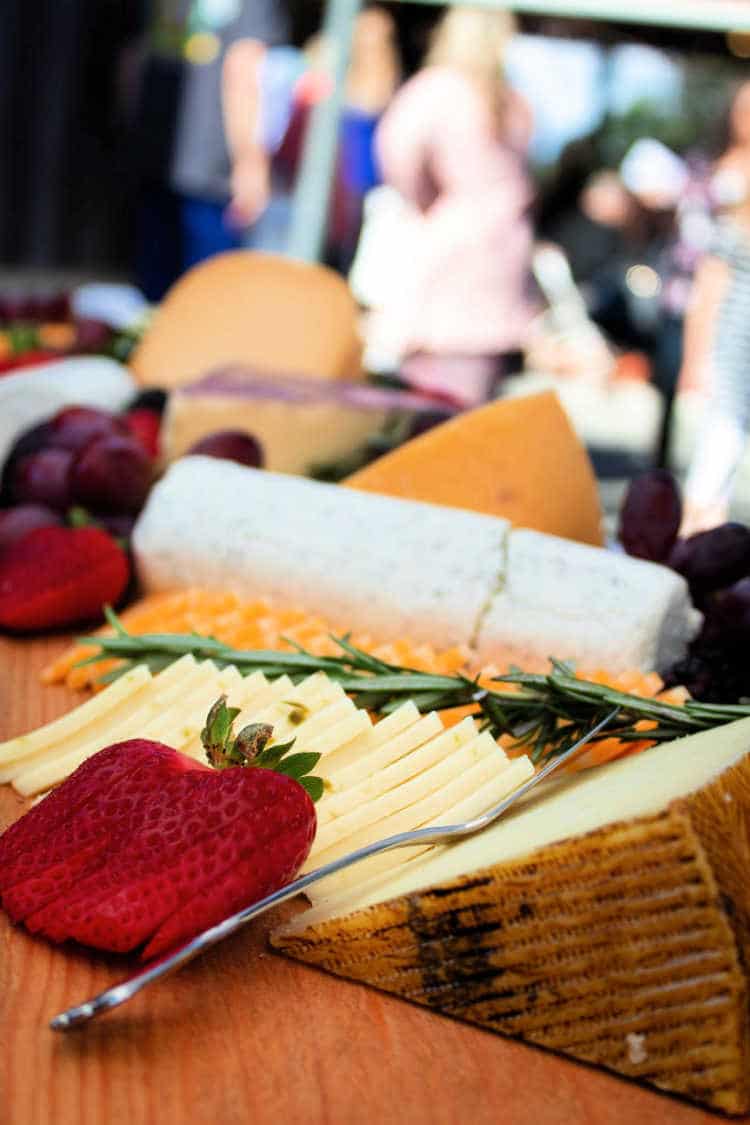
How to Serve a Cheese Platter
While there are no hard and fast rules about how to assemble the components of your cheese board, there are some guidelines that will help to hopefully give you some cheese plate ideas you haven’t thought of before.
I have tried to answer most of the questions you might have about serving a cheese course and to provide guidelines for choosing your cheeses and your accompaniments.
If you have more questions I have not covered, please feel free to email me, and I will get back to you as soon as I can!
Pastry Chef Online Participates in Affiliate Programs. If you make a purchase through one of my links, I may earn a small commission. For more information click to read my disclosure policy
How Many Cheeses Should I Plan on Serving?
I keep the variety of cheese on my cheese platters to no more than five.
Serve an odd number of cheeses. Our eyes like to look at odd numbers of things because odd groupings are more dynamic.
I vote go with three or five cheeses, although the cheese police will not come and take you away if you choose to serve two or four.
Six might be pushing it, though. You don’t want to overwhelm folks by Sheer Force of Numbers.
How Much Cheese Per Person Should I Plan For?
If you’re serving your cheese plate for your dessert course, I would plan on 2-3 oz of cheese per diner along with whatever condiments, breads, and crackers you are providing.
For a cheese board appetizer, expect guests to plow through 3-4 oz per person. Of course, if you decide to add cured meats to your board, that might cut down in the cheese serving size by a bit.
If you’re serving meats on your board, plan on 2-3 ounces per guest as if you were serving it in place of dessert.
How to Choose the Cheese for a Cheese Course
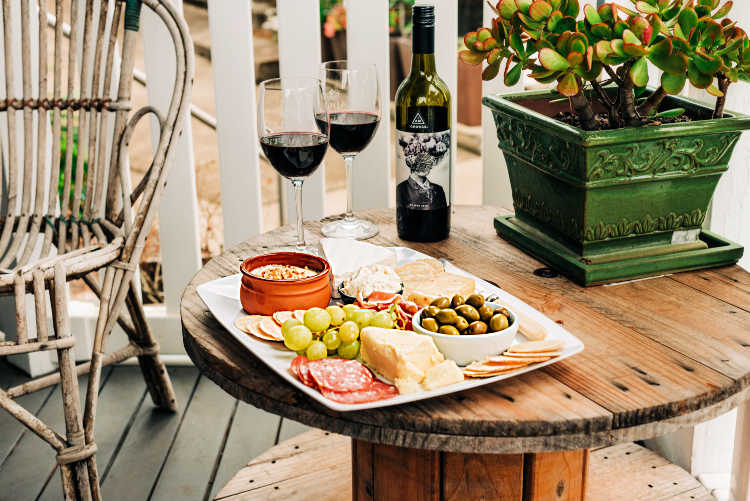
Choose cheeses that differ from each other in various ways:
- color (white, pale ivory, cream, golden, orange, etc)
- aroma (milky, sharp, funky, sweet, etc)
- type of milk (primarily cow, sheep, goat)
- style of cheese (aged, washed rind, fresh, veined, etc)
- texture/firmness (soft and spreadable all the way up to hard and crumbly)
As long as you are an equal opportunity cheese lover, try to have at least one of the following:
- blue-veined cheese
- maybe a triple creme and/or washed rind (stinky) cheese such as Brie or Taleggio
- mild, soft cheese like Havarti or Gouda
- a non-cow’s milk cheese or two (goat’s milk, sheep’s milk).
Cheddar, Havarti, Gouda, and Swiss (Gruyère, Emmentaler) are almost universally approachable, so adding one or both of these to your board will make everyone happy.
What About a Cheese Flight?
I love the idea of serving 3-5 different types of the same kind of cheese.
For example, if you wanted to serve a cheddar cheese board, you could serve 3-5 among these choices:
- smoked cheddar
- young cheddar
- cheddar cheese curds
- 1-year aged cheddar
- 3-year aged cheddar
- mild cheddar
- sharp cheddar
Can I Use Vegan Cheese?
Absolutely. Not too long ago, there weren’t many choices for vegan cheese.
Now there are several good brands, including artisan style cheeses.
There are also recipes for you to make your own vegan cheese if you are feeling very fancy.
Vegan Cheese Brands
I am by no means an expert on vegan cheese. I have heard excellent things about the Daiya brand. So if I as a non-vegan have heard about it, Daiya is probably a great place to start.
The brand I know of making truly excellent artisan cheeses is Miyoko’s Creamery. I enjoyed a few of Miyoko’s vegan cheeses at a vegan dinner party I went to a couple of years ago, and they were incredibly good.
Other brands to look into:
Make Your Own Vegan Cheese (Vegan “Cheez”)
Here are some vegan cheese recipes to consider when settling on your cheese plate ideas. All are from trusted sources, so check them out.
What Should I Serve The Cheese On?
You can absolutely present your cheese plate on a regular dinner plate for individual servings.
Or arrange the cheese on your favorite Thanksgiving platter if it will be a shared or passed appetizer at a party.
There are some great options for serving if you’d like to get a bit fancier. A slate cheese board makes a great backdrop for a cheese course as do wooden boards.
Would you like to save this post?
Other cheeses that would work for flights include different ages and styles of Gouda, blue cheese, washed rind cheese, or goat cheese.
Another type of cheese flight could be sampling cheeses all from one country or from one region of a country.
Consider showcasing local cheeses. There are small creameries all over the country, so if you do a bit of checking, I bet you will find at least one or two in your county or state.
What Order Should I Serve the Cheese In?
The only way you’ll have real control over the order is to serve them one at a time.
If you serve your cheese plate with 3, 4, or 5 choices, suggest to your diners an order, but don’t tell them what to do or they will get cranky!
Suggest sampling the cheese in order from mildest to most…fragrant. And also suggest they try each cheese with each of the condiments or accompaniments you have provided.
Beverage Pairings
It is classic to pair cheeses with wine, but these days, you could also consider a beer and cheese pairing or be really hip and do a cheese and cider pairing.
What Temperature to Serve Cheese
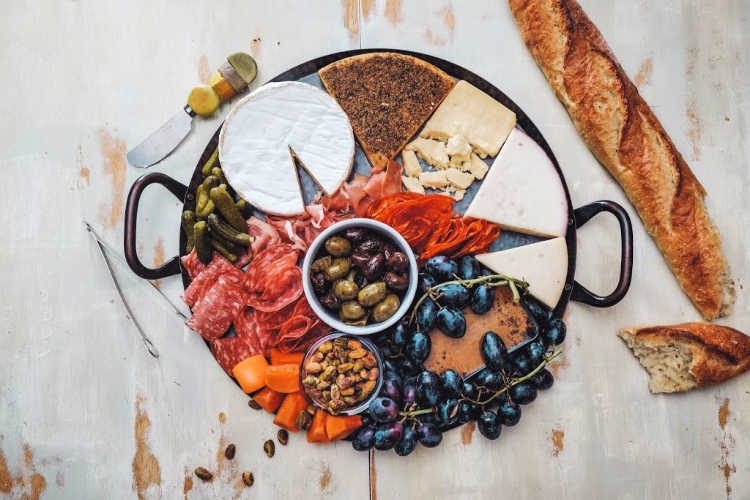
Like wine, the flavor of cheese can be very complex and layered.
Cold deadens flavor and aroma, so it’s best to serve cheese at cool room temperature to bring out the individual characteristics of the cheese.
Aside from aroma and flavor, the texture of cheese changes when allowed to come to room temperature. For example, a crumbly/soft goat cheese will warm up into a gorgeous spreadable texture.
All cheese will soften up a bit when allowed to temper on the counter. A softer, less-chilled cheese will have more nuance in both aroma, flavor, and texture than the same cheese served straight from the fridge.
Allow your cheese to sit out, covered so it doesn’t dry out, for a good 45 minutes to an hour before serving.
Cheese Board Accoutrements
While you can absolutely just serve the cheese alone, your board will be more balanced and more interesting if you serve some accompaniments.
Serve an array of condiments that will either contrast with or complement the flavors and/or textures of the cheese. Some ideas to consider:
- cornichons (wee pickled cucumbers)
- other pickled vegetables (this pickled okra is fantastic)
- aged balsamic vinegar
- interesting savory jams and chutneys like plum chutney, peach plum jam, peach tomato jam, or bacon jam
- fresh, juicy fruit such as apple slices, pear slices or grapes
- dried fruits such as dates, figs and even plump raisins
- chutneys, jams, honey
- onion jam. Absolutely.
- fruit compote
- grainy mustard
- roasted and/or spiced nuts (try these honey roasted cashews)
- Marcona almonds (I am listing these separately because they are The Best)
- cured meats (be sure all your guests eat meat. Adding cured meats turns it more into a charcuterie board than a cheese board, but there is no rule saying you can’t add meats if you want)
How to Slice the Cheese for your Cheese Board
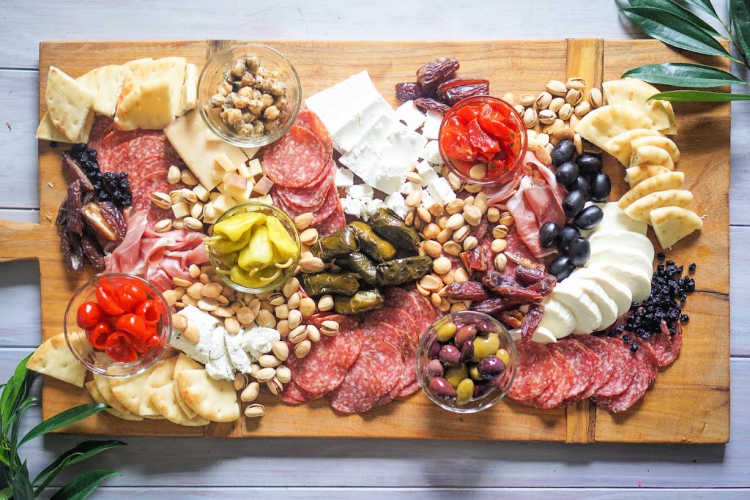
Slice the cheese in portions–small wedges, chunks, slices, rectangles–however you want.
Just don’t put a big honking wheel of cheese out and let your guests hack at it with cute little spreaders.
In that scenario, nobody wins the the cheese definitely loses.
Yes, serving big wheels or whole wedges of cheese gives the impression of abundance, but all the photos are taken before the eating and cheese butchery starts. Nobody takes photos of the cheese carnage aftermath!
A Note About Cubed Cheese
There are some cheese board elitists out there that say cutting the cheese into cubes isn’t very elegant. But you know what? Cubes are cute. Like little dice made of cheese.
If it makes you happy to cube your cheese, I am not going to tell you that you can’t. Go forth and cube, friends.
Can I Just Pour Something Over Cream Cheese
The jar of something poured over a block of cream cheese is an easy appetizer idea that has sort of been relegated to the land of kitsch.
I have to say, though, one of my favorite ways to serve cream cheese as an appetizer is pouring over a homemade sweet/tangy/sour sauce the moms in our neighborhood all made to take to parties.
The best sauce to pour over cream cheese, what I grew up knowing as “red sauce,” is pure comfort food, but I only allow myself to have it at Christmas, otherwise I’d eat it every day. It is that good.
Other good options are apple and green tomato chutney, Jezebel Sauce, store bought chutney such as Major Grey’s, and pepper jelly.
What Sort of Bread Should I Serve with Cheese?
Serve a fairly neutral-flavored cracker or crostini so the flavor of the bread does not compete with the flavor of the cheese and condiments.
As much as I like bread and crackers, they take a back seat on a cheese plate. Their job is to help you get the cheese and condiments to your mouth!
Cheese Plate Ideas: Serving the Condiments
If the condiments are very thick spreads, you could potentially place them directly on your cheese board.
This always looks great. Until people start eating.
Then you end up with condiments smeared into cheese smeared into spiced nuts, and that’s just not good.
A better plan is to serve all your condiments and accompaniments in small ramekins or dishes.
It will help me and other readers so much if you take a moment to rate and leave a review for this recipe.
You can use the stars to rate 1-5 (5 is best), and leave a review in the comments. It helps me make adjustments if any are needed, and comments help others decide whether the recipe is worth making.
Other ways to share include pinning, and/or sharing on your favorite social media platform.
Thank you so much for taking the time!

And there it is. No go forth and put together a beautiful cheese course for your next get together.
Thanks for spending some time with me hopefully getting some good cheese plate ideas!

Hi, y’all! I hope you’ve enjoyed this post and hopefully also learned a thing or two.
If you like my style, I invite you to sign up for my occasional newsletter, The Inbox Pastry Chef.
Expect updates on new and tasty recipes as well as a bit of behind-the-scenes action. I hope to see you there!
Take care, and have a lovely day.




Join in Today!
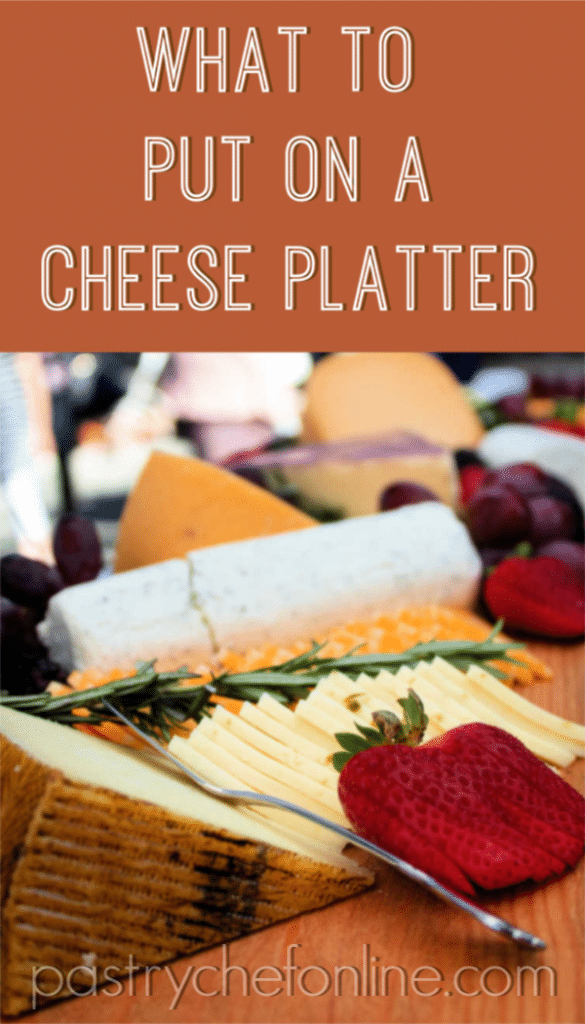

A good cheese plate is my kind of dinner! LOL! Loving all of your ideas! Can’t wait to serve up my next cheese plate!
Cheese for everyone! And as far as I’m concerned, there is never a wrong time for cheese!
Great video Jenni and of course the Beloved did a great job too.
Aw thanks, Marlene! What can I say, sometimes you strike it rich with cheap labor! lol =)
My kind of cheese plate yes! I think choosing cheese is one of life’s delights. Nothing nicer than going to the cheese shop and trying out the hundreds of cheeses for size. Its like a culinary visit to the united nations.
I love trying out new cheeses too. I try and limit cheese platters to once a week after dinner but its difficult. There are so many you can include a new one each week and never run out of choices if your shop is good enough. I try and choose cheeses from different nations each time but definitely a young sweet soft, salty nutty hard old, creamy soft sweet, creamy blue, young goats, hard sheeps…ok thats enough already.
I would be interested in hearing about American cheeses as we don’t get any of those here, only old world cheeses from Europe.
There are quite a lot of really good American-made cheeses Anton, although many folks still consider the “Old World” cheeses to be the gold standard. I highlight a couple in the post in the shopping section. Humboldt Fog is a gorgeous goat’s milk cheese and Tillamook is a beautiful cheddar. Maytag blue is also a famous American bleu cheese. I may work up a post on American cheeses. Thanks for the idea!
I think that would be a good idea. You know it took forever for Amercan wines to gain greater exposure and acceptance. Before that people didn’t even consider them an option. Now of course we all know differently and some are just so in demand that they’ve become almost unobtainable. Same for cheeses except if you hadn’t just mentioned those three that you just did I wouldn’t have honestly probably ever have known.
The world just knows what to avoid “American cheese” that highly processed cheese like substance they put on Mc Donalds burgers.
I recently discoverd some stunning cheeses on Tasmania Australia for example, who would’ve thought Australian cheeses! Some of them are up there with the best in Europe in my opinion.
What would be your recommendation for the amounts of cheeses and accompaniments to have per person? I know it depends on the occasion. How about if it were a wine and cheese party where the cheese etc. would feature in place of dinner? How about when served fancified-style as a last course?
p.s. that fruit and veggie knife is genius! I Definitely Do Not have enough gadgets in my kitchen. I definitely have enough room for juuuuuust one more thing. I’m sure of it. 😉
Good question, Jenny. I would think if you’re having just wine and cheese in lieu of dinner, you’d want to allow for 4-5 oz cheese per person, realizing some will eat less. And also have plenty of fruit to go with it because having nothing but cheese for dinner is a bit much! As a last course, especially if you’re plating individually, I’d shoot for a maximum of 2-3 oz total per plate. After a big dinner, I wouldn’t want to allocate more than 200-300 calories for dessert!
LOL – I didn’t exactly mean to imply cheese for dinner… although I may or may not have had a cheese cube meal once or twice. I meant more like heavy hors-d’oeuvre. And I’m glad for your recs, because I seriously would be contemplating like half a pound per person.
Just figure roughly 100 calories per ounce of cheese and plan accordingly, Jenny! =)
I LOVE this post. Great suggestions and your video is fabulous. The Beloved shines!
Isn’t he a natural, Betsy?! =)
Okay, this was a great post and funny, too. I love the video! Can I only add two things? Anyone who serves a cheese platter should explain the order the cheeses are to be eaten (well, unless you are all for a free-for-all): cheeses should be eaten from mildest to strongest so the flavor of the milder cheese isn’t knocked out by the stronger or saltier cheeses. Also, when cutting a cheese with a rind or an outside edge, cut the cheese so everyone has the same amount of cheese and rind or edge and one unlucky guest doesn’t end up with all the rind! Just my two cents!
Love this post and am going to share!
Excellent additions, both! xo Thanks, friend!
Im not a free for all, but nor do I agree (: Some cheese clean the palate in readiness for the more pungent and if you eat another pungent straight after a pungent it can be too very confused and over powering, not even wine can help. You often need to revert to the sweeter or cleaner. Fruit wine etc all helps but of course so do the cheeses in combination. Chevre after Cambozola cleans and brightens the palate taken with grapes for example, nice mature hard crystiline Comte followed by sweet young Gouda with some crispy apple…….crescendo followed by decrescendo and e.t.c (;
I love that. And yes, it’s fun to play around with combinations and trying different condiments with the different cheeses to see what happens. I think both you and Jamie have valid points. I guess you could instruct your guests to try it either way feels right to them!
It is fun and its fun discovering these things out for yourself. When you watch people eating cheese platters after the intial taste/nibble of all on offer they kind of it get right all by themselves. Its a reaction to the various tastes, strenghs ,saltiness etc. You just need to give them a spread exactly like yours so they can do it right.